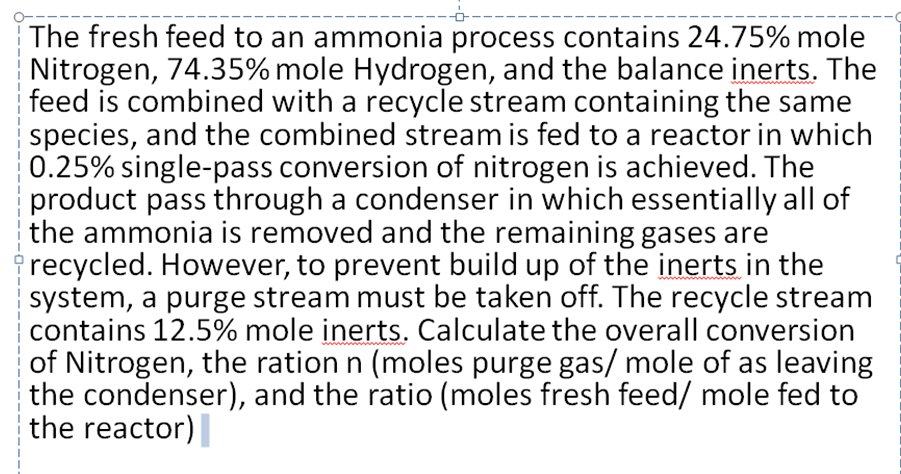The fresh feed to an ammonia process contains 24.75% mole Nitrogen, 74.35% mole Hydrogen, and the balance inerts. The feed is combined with a recycle stream containing the same species, and the combined stream is fed to a reactor in which 0.25% single-pass conversion of nitrogen is achieved. The product pass through a condenser in which essentially all of the ammonia is removed and the remaining gases are recycled. However, to prevent build up of the inerts in the system, a purge stream must be taken off. The recycle stream contains 12.5% mole inerts. Calculate the overall conversion of Nitrogen, the ration n (moles purge gas/ mole of as leaving the condenser), and the ratio (moles fresh feed/ mole fed to the reactor)
The fresh feed to an ammonia process contains 24.75% mole Nitrogen, 74.35% mole Hydrogen, and the balance inerts. The feed is combined with a recycle stream containing the same species, and the combined stream is fed to a reactor in which 0.25% single-pass conversion of nitrogen is achieved. The product pass through a condenser in which essentially all of the ammonia is removed and the remaining gases are recycled. However, to prevent build up of the inerts in the system, a purge stream must be taken off. The recycle stream contains 12.5% mole inerts. Calculate the overall conversion of Nitrogen, the ration n (moles purge gas/ mole of as leaving the condenser), and the ratio (moles fresh feed/ mole fed to the reactor)
Introduction to Chemical Engineering Thermodynamics
8th Edition
ISBN:9781259696527
Author:J.M. Smith Termodinamica en ingenieria quimica, Hendrick C Van Ness, Michael Abbott, Mark Swihart
Publisher:J.M. Smith Termodinamica en ingenieria quimica, Hendrick C Van Ness, Michael Abbott, Mark Swihart
Chapter1: Introduction
Section: Chapter Questions
Problem 1.1P
Related questions
Question

Transcribed Image Text:The fresh feed to an ammonia process contains 24.75% mole
Nitrogen, 74.35% mole Hydrogen, and the balance inerts. The
feed is combined with a recycle stream containing the same
species, and the combined stream is fed to a reactor in which
0.25% single-pass conversion of nitrogen is achieved. The
product pass through a condenser in which essentially all of
the ammonia is removed and the remaining gases are
recycled. However, to prevent build up of the inerts in the
system, a purge stream must be taken off. The recycle stream
contains 12.5% mole inerts. Calculate the overall conversion
of Nitrogen, the ration n (moles purge gas/ mole of as leaving
the condenser), and the ratio (moles fresh feed/ mole fed to
the reactor)
Expert Solution
This question has been solved!
Explore an expertly crafted, step-by-step solution for a thorough understanding of key concepts.
Step by step
Solved in 3 steps with 2 images

Recommended textbooks for you

Introduction to Chemical Engineering Thermodynami…
Chemical Engineering
ISBN:
9781259696527
Author:
J.M. Smith Termodinamica en ingenieria quimica, Hendrick C Van Ness, Michael Abbott, Mark Swihart
Publisher:
McGraw-Hill Education

Elementary Principles of Chemical Processes, Bind…
Chemical Engineering
ISBN:
9781118431221
Author:
Richard M. Felder, Ronald W. Rousseau, Lisa G. Bullard
Publisher:
WILEY

Elements of Chemical Reaction Engineering (5th Ed…
Chemical Engineering
ISBN:
9780133887518
Author:
H. Scott Fogler
Publisher:
Prentice Hall

Introduction to Chemical Engineering Thermodynami…
Chemical Engineering
ISBN:
9781259696527
Author:
J.M. Smith Termodinamica en ingenieria quimica, Hendrick C Van Ness, Michael Abbott, Mark Swihart
Publisher:
McGraw-Hill Education

Elementary Principles of Chemical Processes, Bind…
Chemical Engineering
ISBN:
9781118431221
Author:
Richard M. Felder, Ronald W. Rousseau, Lisa G. Bullard
Publisher:
WILEY

Elements of Chemical Reaction Engineering (5th Ed…
Chemical Engineering
ISBN:
9780133887518
Author:
H. Scott Fogler
Publisher:
Prentice Hall


Industrial Plastics: Theory and Applications
Chemical Engineering
ISBN:
9781285061238
Author:
Lokensgard, Erik
Publisher:
Delmar Cengage Learning

Unit Operations of Chemical Engineering
Chemical Engineering
ISBN:
9780072848236
Author:
Warren McCabe, Julian C. Smith, Peter Harriott
Publisher:
McGraw-Hill Companies, The